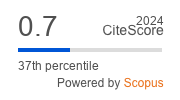Angiolymphoid Hyperplasia with Eosinophilia : a Case Report and Review of the Literature
Keywords:
Angiolymphoid, ALH,, eosinophiliaAbstract
A case of angiolymphoid hyperplasia with eosinophilia (ALH) is reported in a 42-year-old woman who developed multiple nodules behind the ear. Angiolymphoid hyperplasia with eosinophilia usually occurs on the head and neck of young adults and is more common in women than in men. Characteristic histologic features of ALH present in this case included proliferation of thick-walled blood vessels lined by prominent endothelial cells, infiltration of the interstitium by chronic inflammatory cells (mainly eosinophils), and presence of lymphoid follicles with germinal centers. The patient referred for surgeon for complete excision. in this context , cases previously described in the literature, and the differential diagnosis of ALH are discussed.
Angiolymphoid hyperplasia with eosinophilia (ALH) is a rare benign vascular tumor characterized by solitary or multiple red to brown papules or nodules found mainly on the head and neck of young adults between 20 and 40 years of age,1 with a mean age at onset of 30 to 33 years.2 It has also been described in other tissues, including liver, orbit, spleen, palate, bone, heart, and blood vessels.1,3 It is more common in women than in men1 and is associated with peripheral blood eosinophilia of 6% to 34% in about 20% of patients.2,4 The lesions are often pruritic or painful and may coalesce into confluent plaques that are chronic, with little propensity for spontaneous resolution. Itching is significantly greater when the tumor is larger than 2 cm in diameter.1 A history of trauma is found in some patients (9% in the study by Olsen and Helwig4). The interval between trauma and the onset of the lesion ranges from 7 months to 20 years, with a median interval of 30 months.4 Lesion growth, tumor pulsation, and bleeding are other common presentations.2,4 Most intradermal lesions are small, with diameters of 0.5 to 2 cm; subcutaneous lesions may be much larger, up to 5 to 10 cm in diameter.2,5 The tumor is generally intradermal or subcutaneous, but it may involve deep soft tissues and vessels.1 Peripheral blood eosinophilia, enlargement of regional lymph nodes, and arteriovenous shunts have been reported but are variable features.4 We report a case of ALH that presentedas retroauricular nodules in 42-year-old woman.













